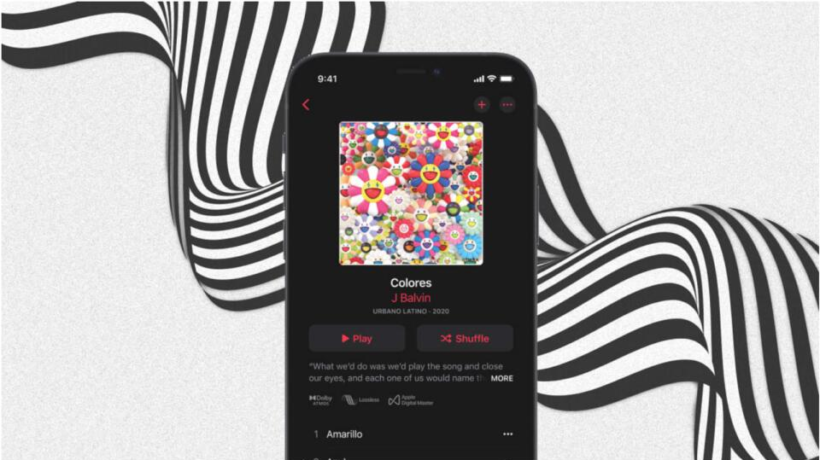Surround-sound and full-fidelity music are great ideas, but both still face technical limitations. Fast Company believes they may not be must-haves for most consumers.
I’ve often gushed about my admiration for Apple’s commitment to music. The company employs a lot of musicians or ex-musicians, and even more music lovers. It’s not trivial: It says something about the company’s culture and the way it approaches creativity and collaboration.
Apple has obviously made many important music-related announcements in its time, but this week’s announcement about Apple Music offering “lossless” and “spatial” audio probably won’t end up rocking the world.
SPATIAL AUDIO
Apple has been working with Dolby to begin making some of the Apple Music catalog available in Dolby’s proprietary Atmos format. Those recordings are meant to sound something like the experience of watching a movie with surround-sound technology, where sounds might come from behind you, above you, or anywhere else within a spherical audio surface around you. And sounds can move around in that space, so a guitar solo might seem to slowly circle above your head (which is cool, because guitar solos are boring).
Apple says it’s going to start off with a few thousand Atmos songs in June, including some from Ariana Grande, Kacey Musgraves, and others, and then add more tracks over time. When the spatial support launches next month, Apple devices will be set to play available songs by default, rather than the regular binaural mix.
I’ve no doubt the Atmos mixes themselves will be true to the spatial concept. It’s indeed possible to do a spatial audio mix where sounds are coming at the listener from every direction. (Dolby is supplying production studios with special software for designing these mixes.) The problem comes with accurately reproducing that mix in the ears of consumers.
Apple says the recordings will work well on AirPods, Beats, and pretty much every other pair of earphones. But none of those devices are equipped with software to optimize them for spatial music. They are still using the left-speaker, right-speaker stereo setup, then doing their best to simulate a spherical musical space where sounds can move around.
I’ve heard Sony’s attempt at doing this with its 360 Reality Audio and was unimpressed. The Sony spatial mixes sounded compelling when I was sitting in a music studio with speakers all around me listening to a performance of the mix that had been specially tuned for my ears. But listening to a 360RA mix on my own Sony headphones at home (via Tidal) was decidedly less convincing. I could hear hints of sounds happening around and behind me, but they were ill-defined, and far from the holy-shit moment when you jerk your head around to see what’s making that noise behind you.
I could be wrong—I hope I am—but I fear I’m in for a similar letdown with the Dolby Atmos mixes on Apple Music.
“LOSSLESS” MUSIC
The second part of Apple’s announcement today concerns “lossless” music, or music that retains the full fidelity of the studio recording. Apple says it wants people to hear the music as the artist intended.
The company says it will offer three different tiers of lossless music tracks, all delivered through the Apple Lossless Audio Codec (ALAC). The first two are branded as “Lossless.” The first is CD quality, at a bit depth (more bits meaning a wider dynamic range in the recording) of 16 bits and a 44.1-kilohertz sample rate (meaning the audio recording software has sampled the sound of the analog instrument or voice 44,100 times per second). But you’ll be hard-pressed to find any pro studio recording with anything less than 24 bits and 48 kHz. The second tier of Apple Lossless is exactly that—24 bits at 48 kHz.
Apple says that when Apple Music plays natively on Apple devices, meaning the speakers of iPhones, iPads, and Macs, the player will automatically default to a Lossless file if one is available. I’m very skeptical that people will be able to appreciate the improved resolution on these little speakers. But I’ll reserve judgment until I hear it. Apple says it will eventually offer lossless versions of every song in its catalog.
The highest-quality tier is called “Lossless High Definition.” This tier supports 48-bit audio and a sample rate of up to 196 kHz. Now we’re up in audiophile territory. You won’t be able to enjoy these tracks using AirPods or any other Bluetooth-connected device; Bluetooth doesn’t support truly lossless compression standards. After all, lossless music files can be 25 times larger than the compressed AAC files streamed on Apple Music.
To hear Lossless High Definition you’ll need a particular kind of digital audio converter (DAC), which converts digital music into an analog signal that can be pumped out of speakers. You can buy a decent DAC for a couple of hundred dollars to use with your home stereo system. You can also buy a smaller DAC that connects to your iPhone and sends lossless to a pair of headphones.
Most people probably won’t bother. Yes, there will always be the audiophile crowd, but accurate, high-fidelity music production isn’t a mainstream interest in the 21st century and hasn’t been since, arguably, the 1970s (check out the beautiful Steely Dan recordings). These days we’re more interested in the mobility, not the fidelity, of our music, so most of us are satisfied with listening to highly compressed (“brick-walled”) production that sounds good enough on smartphone/earphone setups and low-cost Bluetooth speakers.
The good news is that if you’re an Apple Music subscriber you won’t have to risk much to try out these new music formats. Both Spatial and Lossless come at no additional cost, starting in June.
____________________________________________________________________________________
Author: Mark Sullivan. Article published in collaboration with fastcompany.com.







